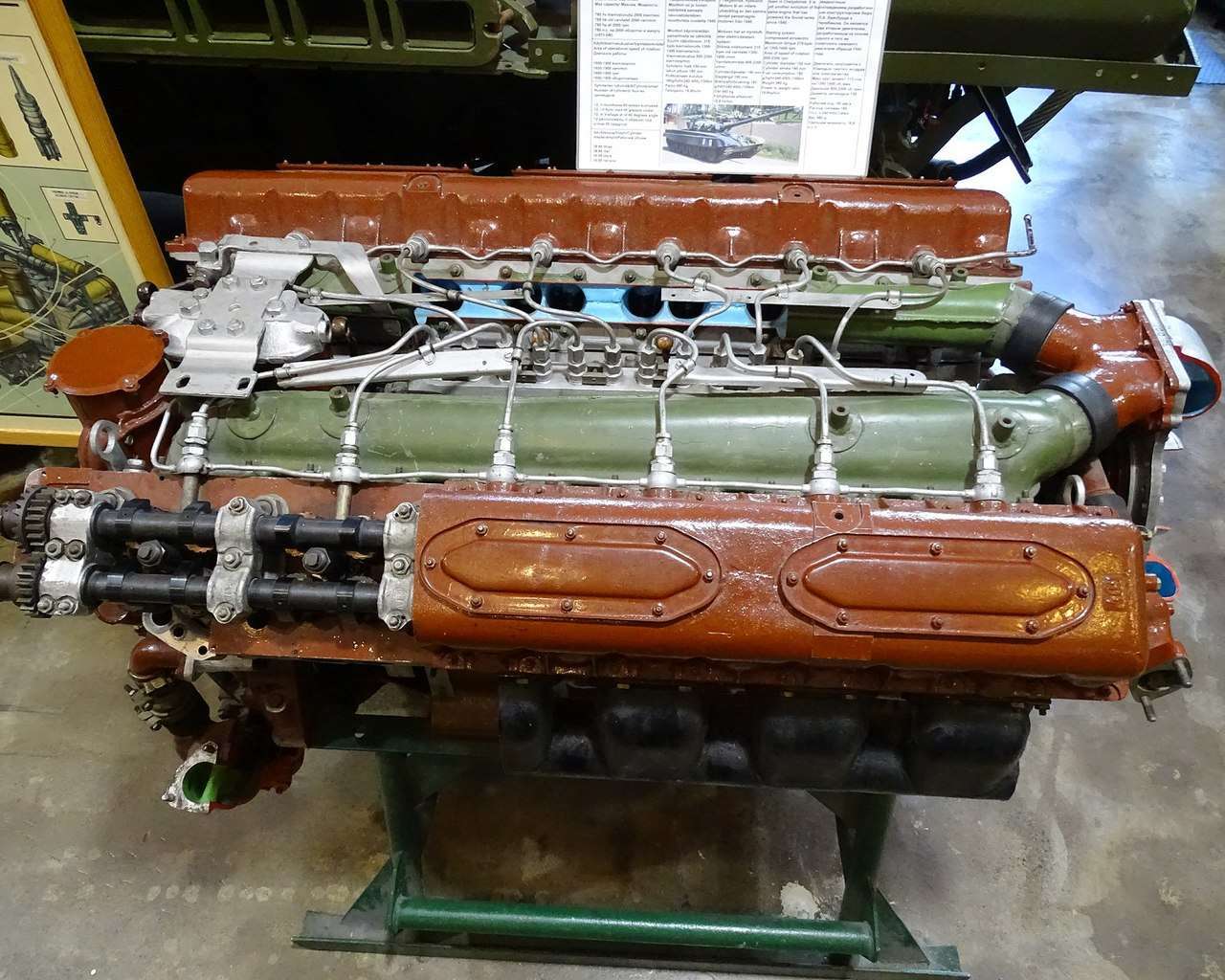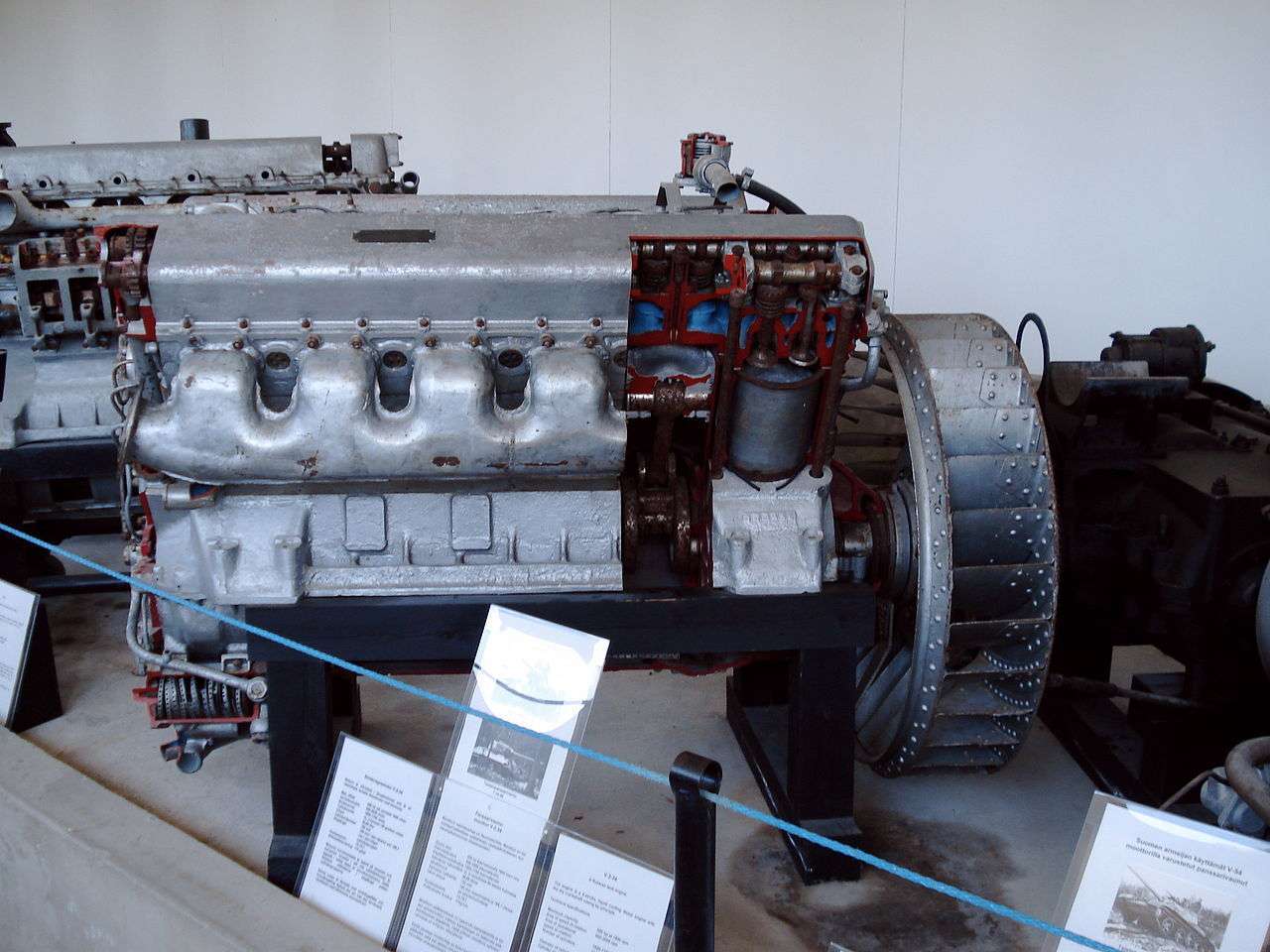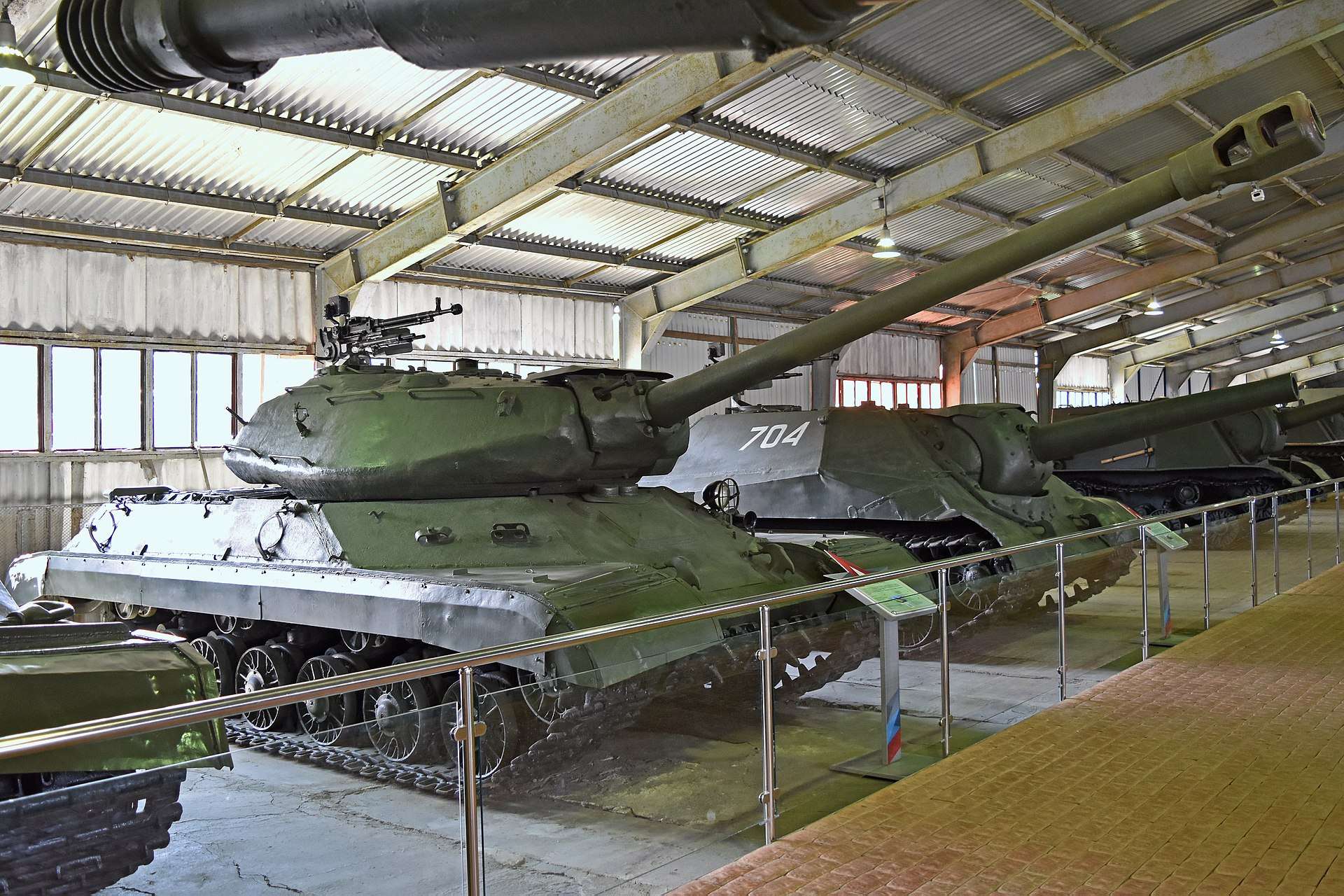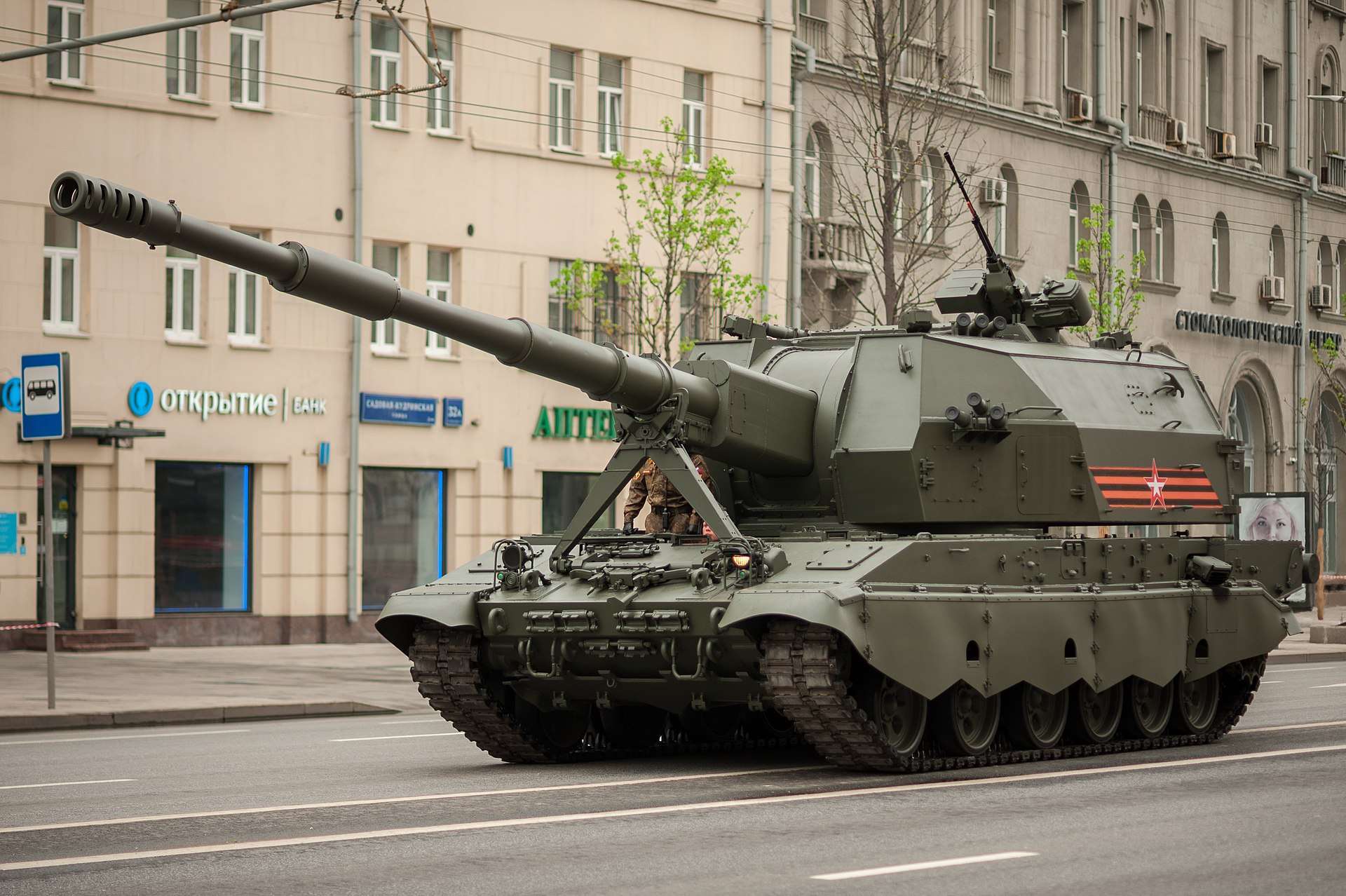
V-2 – The 90 Year Old Engine Used From the T-34 to the T-90M
The V-2 engine is a diesel V12 designed by the Soviet Union in the 1930s, and is most famous for powering the hordes of T-34s fielded during the Second World War. However, work on this engine continued on, being used in the T-54, T-62, T-72 and T-90. Yes, you read that right, many of Russia’s current main battle tanks use a modified version of the T-34’s engine.
This 38.8 litre beast was not just used in tanks either, as it has powered boats, trains, trucks, engineering vehicles and tractors.
Unfortunately, due to the highly varied and complex history of this engine, there is little available information that shows how the V-2 has evolved over the past 90 years.
 Few engines have outlived the V-2. Image by Richard Allen CC BY 2.0.
Few engines have outlived the V-2. Image by Richard Allen CC BY 2.0.
But fear not, as in this article we look at the history behind this remarkable engine and cover many of the most significant uses and versions of the V-2.
This is probably one to bookmark, as we hope it can serve as a reference for your own research on this important, yet rather obscure engine.
Development history
The development of the V-2 started in 1931 as a potential new engine for future Soviet tanks and aircraft. It was developed in the Kharkiv Locomotive Factory by a team of designers lead by Konstantin Cheplan.
The idea of a diesel engine fit for both tanks and aircraft was favored by the specialists in the Directorate of Mechanization and Motorization of the Red Army in the 1930s. Soviet abilities to produce high quality petrol – especially aviation grade petrol – was limited at this time, so diesel engines were seen as a more reliable alternative across many industries.
In addition to this, the lower fuel consumption of diesel engines was attractive.
The Soviets famously used diesel engines in their tanks during WWII, while most Allied and German tanks ran on petrol. Image taken at TANKFEST 2022.
Cheplan had taken note of the AD-1 aviation engine project created by Jacob Mayer from the Ukrainian Avio-diesel Reasearch Institute in 1931.
He took several ideas from Mayer’s engine, such as the use of steel threaded rods inside an aluminium crankcase and block. This use of aluminium was quite advanced for the era, with most contemporary engines using cast iron blocks.
The V-2 was in direct competition with the AN-1 diesel engine. The AN-1 was created by lead designer Alexey Charomskiy, and like the V-2, was a diesel V12. It would eventually see use in Soviet heavy bombers, and a version of this engine, the M50-T, powered the IS-7 heavy tank.
 This is an ACh-30, a later development of the AN-1. Some experimental versions of this engine would produce up to 2,000 hp during the Second World War. Image by Alf van Beem.
This is an ACh-30, a later development of the AN-1. Some experimental versions of this engine would produce up to 2,000 hp during the Second World War. Image by Alf van Beem.
Under the recommendation of aviation engine designer Vladimir Klimov, the V-2 engine had the same cylinder width as the Klimov M-100 aviation engine (a licensed copy of the Hispano-Suiza 12Y).
The V-2 was an impressively modern design for the 1930s, with double overhead cams and four valves per cylinder. It displaced a huge 38.8 litres (2,367.7 cu in) and, in its initial variants, had an output of 500 hp and over 2,000 Nm of torque.
An interesting quirk of the V-2 is that its stroke (how far the piston moves up and down the cylinder) was different for each bank. The left bank has a stroke of 180 mm, while the right bank has a stroke of 186.7 mm.
This is because the engine used master-and-slave piston rods, an arrangement where multiple connecting rods are attached to a single main bearing on the crankshaft. This reduces the amount of room needed to connect all pistons to the crankshaft, reducing the crankshaft’s length in engines with large numbers of pistons.
 A partially dissected V-2 engine, showing features such as the large pistons, double overhead camshafts and steel rods. Image by Balcer CC BY 2.5.
A partially dissected V-2 engine, showing features such as the large pistons, double overhead camshafts and steel rods. Image by Balcer CC BY 2.5.
The V-2 went though many trials, with tanks fitted with the engine undergoing testing before a government commission in 1935.
The following year, a P-5 aircraft flew with the BD-2A diesel engine, a forced induction version of the V-2 that produced 600 hp. It went through flight trials successfully, but the engine was never used again in aviation as the role would be filled by other engines, such as the previously mentioned AN-1.
In 1937 the engine received it’s designation; V-2.
The lead designer, Cheplan, was awarded an Order of Lenin for his work, but shortly after fell victim to Stalin’s purges. Timofey Chupahin became the new lead designer for the engine.
 Konstantin Chelpan was likely unaware that the engine he helped create would become one of the longest lasting military engines ever. Image by Hornet Driver CC BY-SA 3.0.
Konstantin Chelpan was likely unaware that the engine he helped create would become one of the longest lasting military engines ever. Image by Hornet Driver CC BY-SA 3.0.
Chupahin was part of the team working on the AN-1 engine and used all his available knowledge and experience to make the V-2 more reliable.
In 1938, three engines used in trials failed due to mechanical issues, however in 1939 the engine passed the government trials with satisfactory results and it entered serial production in factory №75 of the Kharkiv Locomotive Factory.
The V-2 during WWII
First off, it’s good to note that all engines of the V-2 family used during the Second World War are diesel only, but not all of them were V12s.
Beware: the naming and cylinder arrangements of these engines can get a little confusing because of their “V”-shaped cylinder layouts and “V-” designations.
The first versions of the V-2 were used on the BT-7M light tank, vehicles that were heavily involved in the testing of the engine.
 The BT-7M, shown here, was used extensively to test the V-2 engine. Image by Хворостянов А.С. CC BY-SA 4.0.
The BT-7M, shown here, was used extensively to test the V-2 engine. Image by Хворостянов А.С. CC BY-SA 4.0.
It was also fitted to the first series of T-34 tanks in 1940, but was soon replaced by the V-2-34. This was used on all versions of the tank until the end of WW2, the last of which was the T-34-85.
Naturally the V-2-34 was used by variants of the T-34, such as the SU-85, SU-100 and SU-122 self-propelled guns.
Another version, the 600 hp V-2K, was fitted to KV-1 and KV-2 heavy tanks in 1939. The same engine was used on the KV-1S from 1942 and SU-152 heavy self-propelled gun from 1943. This type had higher fuel injection pressure and ran at a higher RPM, making it more powerful but less reliable.
A V-2K beside a KV-1, the vehicle it powered. Image taken in The Tank Museum.
The 520 hp V-2-IS (V-2-10) was developed for the late war heavy Soviet IS tanks and vehicles using the same chassis, these include the IS-1 and IS-2 heavy tanks, as well as the heavy self-propelled guns ISU-122, ISU-122S and ISU-152.
IS-3 heavy tanks were powered by the 520 hp V-11, which was developed into the V-44, used in the T-44 medium tank. The V-44 was mounted sideways in the T-44, and incorporated design elements to reduce the engine’s height, therefore reducing the tank’s overall profile.
 The IS-3 shocked Western leaders when it was revealed. However it turned out to be rather lacklustre. Image by Billyhill CC BY-SA 4.0
The IS-3 shocked Western leaders when it was revealed. However it turned out to be rather lacklustre. Image by Billyhill CC BY-SA 4.0
There were two other Soviet vehicles from WW2 that use engines based on the V-2 – the T-50 light tank, which uses the V-4, 300 hp inline-six engine, and the “Voroshilovets” heavy artillery tractor that used the 375 hp V-2V.
The V-4 was made by essentially cutting the V-2 in half to form an inline-six engine.
The V-2 During the Cold War
The V-2’s story does not end with the Second World War, not by a long shot. The engine would continue being developed throughout the Cold War, seeing use in almost every notable Soviet tank.
During the Cold War, all versions of the V-2, both serial and experimental, were produced in the Chelyabinsk tractor plant. However, licensed copies of V-2 engines were built in many countries, including China, India, Iraq and Korea.
Following the Second World War a new version, the V-12, was designed for the IS-4 heavy tank. It was fitted with a supercharger, and produced 750 hp. This version was highly unreliable and produced in small numbers.
 The IS-4 heavy tank, powered by the V-12 V12, confused yet?
The IS-4 heavy tank, powered by the V-12 V12, confused yet?
On the base of the V-12 came the V-12-5 in 1953, a 700 hp engine for the T-10 heavy tank.
The next big step in Soviet tank design came with the T-54. This vehicle was revolutionary for the day, and is considered by many to be one of the first MBTs. It was fitted with the 520 hp V-54 engine, continuing the long development of the original V-2 used in the T-34.
 The V-54, used sideways in the T-54 tank. This arrangement would continue on future Soviet MBTs. Image by Ohikulkija CC BU-SA 4.0
The V-54, used sideways in the T-54 tank. This arrangement would continue on future Soviet MBTs. Image by Ohikulkija CC BU-SA 4.0
Like in the T-44, the V-54 was mounted sideways in the T-54.
A lower-power engine was used for the AT-T, a heavy artillery tractor built on the chassis of the T-54. This was the V-401, which produced 415 hp.
The next step was the 580 hp V-55, used in the T-55 from 1958.
 The extremely bizarre AT-T artillery tractor. This machine was built on a reversed T-54 chassis, with the cab over the V-401 engine. Image by Billyhill CC BY-SA 4.0.
The extremely bizarre AT-T artillery tractor. This machine was built on a reversed T-54 chassis, with the cab over the V-401 engine. Image by Billyhill CC BY-SA 4.0.
The 1960s brought the next generation of Soviet MBT, the T-62. Once again, the T-62 was fitted with modern versions of the V-2, beginning with the 580 hp V-55V. Later upgrades to the tank saw power increase to 620 hp.
Less than a decade after the T-62 came the T-72, an MBT that followed the basic layout of previous vehicles but brought a major leap in capability. Powering this vehicle was, yet again, another derivative of the V-2.
The T-72 was a cheaper and more reliable derivative of the T-64, and is one of the most produced tanks in history.
Power increased significantly to 780 hp with the multifuel, supercharged V-46 and later the V-46-6.
The two export versions of the T-72, the T-72M from 1980 and T-72M1 from 1981, also use the V-46-6. A variant of this engine, the V-46-M5, is used on the 1985 T-62M-1.
The self-propelled anti-air 2K22 Tunguska from 1982 used a 710 hp version of the V-46 too.
 The Tunguska is armed with a pair of 30 mm cannons and eight missiles for use against low flying aircraft. Image by Schneeleopard2 CC BY-SA 4.0.
The Tunguska is armed with a pair of 30 mm cannons and eight missiles for use against low flying aircraft. Image by Schneeleopard2 CC BY-SA 4.0.
After 1984, T-72A, T-72B and all other modifications of the tank until the end of the Cold War were fitted with the V-84 series of multifuel engines with 840 hp.
The V-84A, V12, 780 hp, multifuel, diesel engine is used on the 2S19 “Msta-S” self-propelled howitzer that entered service in 1989.
 A V-46-6 from a T-72. This engine is still visually similar to the original V-2. Image by Banznerfahrer CC BY-SA 3.0..
A V-46-6 from a T-72. This engine is still visually similar to the original V-2. Image by Banznerfahrer CC BY-SA 3.0..
The V-2 in the Modern Day
Despite being around 70 years old, the V-2, albeit in modernised form, found itself powering Russia’s third generation MBT, the T-90.
At first the T-90 featured the 840 hp V-84MS, however the subsequent T-90A from 2004 uses the newer, turbocharged V-92S2 that produces 1,000 hp.
This same V-92S2 engine can also be found on the new 2S35 Koalitsiya-SV self-propelled gun.
 The 2S35 Koalitsiya-SV is one of the newest Russian heavy AFVs. Image by Dmitriy Fomin CC BY 2.0.
The 2S35 Koalitsiya-SV is one of the newest Russian heavy AFVs. Image by Dmitriy Fomin CC BY 2.0.
In 2017 the export model T-90M was introduced, resulting in the decision to upgrade current T-90A tanks in the Russian Armed Forces to the T-90M standard.
This tank, the T-90AM and T-90MS feature the upgraded 1,130 hp V-92S2F.
Another vehicle that uses this engine is the Terminator 2 heavy tank support vehicle.
Conclusion
There are few pieces of technology, let alone engines, that have remained in service for as long as the V-2.
This piece of engineering is now around 90 years old, and since its creation has witnessed the Second World War, atomic weapons, the death of Joseph Stalin, man’s foray into space, the internet, the collapse of the Soviet Union and the birth of the Russian Federation.
Despite the many versions of the V-2 since WWII, its most famous usage was in the T-34. Image taken at TANKFEST 2022.
Konstantin Cheplan’s original design from the 1930s has taken many forms, from six, 10 and 12 cylinders, inline, V and X shaped arrangements – even to this day there are new versions based on the V-2 in development.
In this article we covered the most significant examples of the V-2, but there are many, many more uses of this engine in civilian, industrial, marine and military applications that we simply don’t have the room to cover.
The story of this incredible engine that began all the back in 1931 doesn’t look like it will end any time soon.
News
The Hanging Temple: China’s 1,500-Year-Old Cliffside Marvel of Faith and Engineering
The Hanging Temple: China’s 1,500-Year-Old Cliffside Marvel of Faith and Engineering Perched precariously on the cliffs of Mount Heng in Shanxi Province, China, the Hanging Temple, also known as Xuankong Temple, Hengshan Hanging Temple, or Hanging Monastery, is an architectural…
The Willendorf Venus: A 30,000-Year-Old Masterpiece Reveals Astonishing Secrets
The Willendorf Venus: A 30,000-Year-Old Masterpiece Reveals Astonishing Secrets The “Willendorf Venus” stands as one of the most revered archaeological treasures from the Upper Paleolithic era. Discovered in 1908 by scientist Johann Veran near Willendorf, Austria, this small yet profound…
Unveiling the Maya: Hallucinogens and Rituals Beneath the Yucatán Ball Courts
Unveiling the Maya: Hallucinogens and Rituals Beneath the Yucatán Ball Courts New archaeological research has uncovered intriguing insights into the ritual practices of the ancient Maya civilization. The focus of this study is a ceremonial offering found beneath the sediment…
Uncovering the Oldest Agricultural Machine: The Threshing Sledge’s Neolithic Origins
Uncovering the Oldest Agricultural Machine: The Threshing Sledge’s Neolithic Origins The history of agricultural innovation is a fascinating journey that spans thousands of years, and one of the earliest known agricultural machines is the threshing sledge. Recently, a groundbreaking study…
Nara’s Ancient Sword: A 1,600-Year-Old Protector Against Evil Spirits
Nara’s Ancient Sword: A 1,600-Year-Old Protector Against Evil Spirits In a remarkable discovery that has captured the attention of archaeologists and historians alike, a 7.5-foot-long iron sword was unearthed from a 1,600-year-old burial mound in Nara, Japan. This oversized weapon,…
The Inflatable Plane, Dropped Behind the Lines for Downed Pilots
Experimental The Inflatable Plane, Dropped Behind the Lines for Downed Pilots The Inflatoplane from Goodyear was an unconventional aircraft developed by the Goodyear Aircraft Company, a branch of the renowned Goodyear Tire and Rubber Company, also famed for the Goodyear…
End of content
No more pages to load











